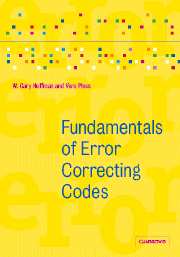Book contents
- Frontmatter
- Contents
- Preface
- 1 Basic concepts of linear codes
- 2 Bounds on the size of codes
- 3 Finite fields
- 4 Cyclic codes
- 5 BCH and Reed–Solomon codes
- 6 Duadic codes
- 7 Weight distributions
- 8 Designs
- 9 Self-dual codes
- 10 Some favorite self-dual codes
- 11 Covering radius and cosets
- 12 Codes over ℤ4
- 13 Codes from algebraic geometry
- 14 Convolutional codes
- 15 Soft decision and iterative decoding
- References
- Symbol index
- Subject index
13 - Codes from algebraic geometry
Published online by Cambridge University Press: 05 June 2012
- Frontmatter
- Contents
- Preface
- 1 Basic concepts of linear codes
- 2 Bounds on the size of codes
- 3 Finite fields
- 4 Cyclic codes
- 5 BCH and Reed–Solomon codes
- 6 Duadic codes
- 7 Weight distributions
- 8 Designs
- 9 Self-dual codes
- 10 Some favorite self-dual codes
- 11 Covering radius and cosets
- 12 Codes over ℤ4
- 13 Codes from algebraic geometry
- 14 Convolutional codes
- 15 Soft decision and iterative decoding
- References
- Symbol index
- Subject index
Summary
Since the discovery of codes using algebraic geometry by V. D. Goppa in 1977, there has been a great deal of research on these codes. Their importance was realized when in 1982 Tsfasman, Vlăduţ, and Zink proved that certain algebraic geometry codes exceeded the Asymptotic Gilbert–Varshamov Bound, a feat many coding theorists felt could never be achieved. Algebraic geometry codes, now often called geometric Goppa codes, were originally developed using many extensive and deep results from algebraic geometry. These codes are defined using algebraic curves. They can also be defined using algebraic function fields as there is a one-to-one correspondence between “nice” algebraic curves and these function fields. The reader interested in the connection between these two theories can consult. Another approach appeared in the 1998 publication by Høholdt, van Lint, and Pellikaan, where the theory of order and weight functions was used to describe a certain class of geometric Goppa codes.
In this chapter we choose to introduce a small portion of the theory of algebraic curves, enough to allow us to define algebraic geometry codes and present some simple examples. We will follow a very readable treatment of the subject by J. L. Walker. Her monograph would make an excellent companion to this chapter. For those who want to learn more about the codes and their decoding but have a limited understanding of algebraic geometry, the Høholdt, van Lint, and Pellikaan chapter in the Handbook of Coding Theory can be examined.
- Type
- Chapter
- Information
- Fundamentals of Error-Correcting Codes , pp. 517 - 545Publisher: Cambridge University PressPrint publication year: 2003



